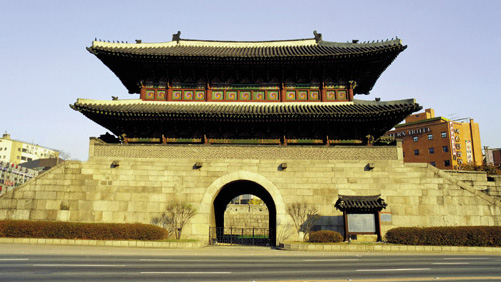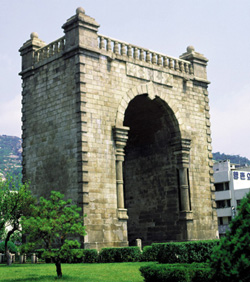|
| Knock to enter a Beautiful World, Gate of Seoul |
| In order to cross from one world to another you have to pass a threshold. In Korea this threshold is a gate. The gate doesn't only have a meaning of space but is also the symbol of an invitation to a new world. With 600 years history as the capital of Korea, Seoul also has many gates from the past to present. Knock on one of Korea¡¯s gates, and you will be invited in to see much of Korea's beauty and history. |
|
 |
|
Faces of Seoul Namdaemun, Dongdaemun
Seoul has been the capital since the Joseon Period(1392 ~ 1910). In 1396, a castle surrounding Seoul was built, and on the four sides, four gates were constructed.
One in each direction of each north, south, east, west, Bukdaemun(north), Namdaemun(south), Seodaemun(west), Dongdaemun(east). Namdaemun, the main gate of the Seoul castle, is the no.1 National Treasure and is located in Namdaemunno 4-ga Jung-gu, Seoul. Namdaemun shows off its elaborate layers and the beautiful line of the roof with a dragonhead. A night lighting system has been installed recently and the view at night is as beautiful as during the day.
Namdaemun is a gate with the meaning of worshiping courtesy. This gate is the oldest wooden building that exists in Seoul today. It is a building that represents Korea with its strong structure and majestic image. The markets and shops around Namdaemun are very popular, too.
The no.2 treasure Dongdaemun is located in Jongno 6-ga, Jongno-gu, Seoul. This gate has the meaning of loving others. Like Namdaemun, around Dongdaemun there are many huge markets. Pyeonghwa market, Heung-in market, Migliore ,and Doosan Tower, to name but a few, are known as a great shopping places.
Gate to Reaching Emancipation, Gate of Buddhist Temple
In Korea, the history and tradition of Buddhism is so long that in the ancient times of monarchy, the national religion was Buddhism. This is why you can find famous temples in Seoul. Temples have a different architectural style then other buildings and it helps to see them thinking of the philosophical meaning.
Usually the Cheonwangmun(gate of the king of sky) is the first thing that catches your eyes when you step into the temple. This name was given because of the four statues of kings of sky are the gods that protect the rules of Buddhism and usually have a face with wide eyes, arched black eyebrows, and a gaping red mouth that can give a fright. They have a big sword, spear and are stepping on a devil. The devil has a face that howls in pain, which represents the defeat of evil spirits from the holy sanctuary.
Since the aim of Buddhism is emancipation, there is the Haetalmun(gate to achieve emancipation) and Bulimun(gate that is not two). The Haetalmun has the meaning to be free from the pain of cycle of life and emancipate. The Bulimun means that there aren't two gates. In other words it means that Buddha and people, the goodness and evil, existence and non-existence are two separate things but all one, which is the Buddhist philosophy.
Hongsalmun Symbol of Honesty and Right Mind
When you visit a castle or royal tomb in Seoul or nearby, you will see a red gate. This is the Hongsalmun. It is usually over 9m high with 2 round pillars and red framework without a roof and a Taegeuk mark in the middle. The Hongsalmun generally meant justice and also indicates the dignity of the nation.
|
|

Gate Where You Can Hear the Howls of History Dongnimmun Independence Gate
Dongnimmun, which is located in Hongjedong, Seodaemun-gu, Seoul, is a gate that was built while wishing for independence when the sovereignty of Korea was in danger because of Japan and the Cheong dynasty.
But after Japan invade Korean, in 1901 they built prisons and supplementary facilities. This place is now known as Seodaemun-gu Independence Park, and displays the execution rooms, basement prison rooms, and torturing facilities.
Olympic Spirit Wishing for World Peace
World peace gate is located in the Seolin Memorial Park within the Olympic Park, Bang-i-dong, Songpa-gu, Seoul. It was constructed in 1988 to express the Olympic spirit dynamically.
The gate which is 24m high, 31m wide and total length of 62m, is a huge structure which shows Korean beauty through curves and emphasizes the leaping and ascending image on the bottom of the wing, which is the roof part of the model. There are pictures of legendary animals such as blue dragons and white tigers. On the front and both right and left of the gate there are each 30-mask poles that greet visitors.
|
|
|
|
| 29-07-2001 |
|

